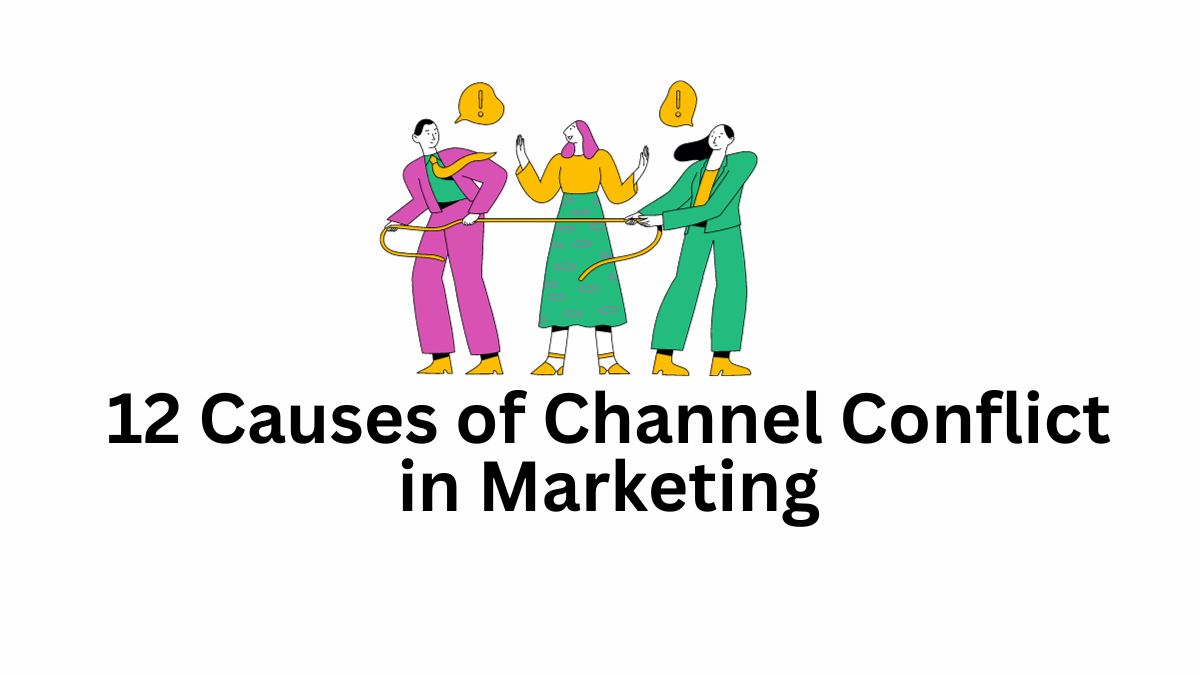Causes of Channel Conflict
Channel conflict refers to any disagreement between two or more channel partners. Numerous reasons can cause this disagreement. Here are the 12 major causes of channel conflict in marketing:
Competing Interests
When partners have diverging priorities, conflicts often arise. Imagine a scenario where a manufacturer seeks to expand its online sales to capture a wider market, while traditional retailers aim to maintain foot traffic in physical stores.
This strategy divergence may create tension as both partners compete for consumer attention and sales, potentially leading to conflicts over resource allocation and marketing efforts.
Differential Pricing
Pricing inconsistencies across channels can be a breeding ground for disputes. Suppose one channel receives exclusive discounts or pricing advantages. This disparity might breed discontent among other partners who feel disadvantaged or less competitive. The perception of unfair treatment in pricing strategies can significantly strain relationships among channel members.
Territorial Overlap
Operating in the same geographical area can intensify competition among partners. When multiple entities share the same territory, disputes may emerge over customer loyalty, market dominance, and sales figures. Such overlaps could trigger conflicts regarding customer outreach strategies and the allocation of marketing resources.
Product Differentiation
Exclusive deals or varied product offerings allocated to specific partners can spark conflicts. Partners might feel undermined or less competitive if others gain access to more attractive products or exclusive rights. This lack of parity in product offerings could lead to friction within the channel network.
Communication Breakdown
Clear and transparent communication is pivotal in channel partnerships. When communication channels falter, misunderstandings proliferate. A lack of shared strategies, updates on promotions, or changes in policies can breed mistrust and suspicion among partners. This breakdown in communication can escalate into conflicts over strategy alignment and mutual expectations.
Read More: What is a Distribution Channel?
Market Saturation
Overcrowding a market with numerous distribution channels can saturate demand and trigger price wars. When multiple partners compete aggressively, profitability dwindles, causing friction among partners vying for consumer attention and sales share. This heightened competition often strains relationships, leading to conflicts over pricing strategies and market dominance.
Technological Disparities
Differences in technology adoption rates among partners can create disparities in performance and customer engagement. Partners with varying tech capabilities might face conflicts over the efficiency and effectiveness of the channel. Discrepancies in digital tools, platforms, or marketing strategies can lead to tension and disputes over customer reach and conversion rates.
Resource Allocation
Unequal resource distribution by manufacturers among their partners can breed dissatisfaction and resentment. When certain partners receive more support or resources, it may fuel feelings of disadvantage among others. This perceived inequality in resource allocation often leads to conflicts over competitiveness and fairness within the channel network.
Read More: What is Reverse Distribution Channel?
Channel Power Imbalance
Power imbalances within partnerships can be a fertile ground for conflicts. Instances where one partner holds more control or decision-making authority can marginalize others, causing dissent and frustration. Conflicts often arise when less influential partners feel disregarded or excluded from critical decisions, sparking tensions over equity and partnership dynamics.
Changes in Distribution Strategy
Significant shifts in distribution strategies, like a sudden pivot to direct-to-consumer models, can disrupt existing channels. These abrupt alterations alter the established ecosystem, creating conflicts due to the sudden reconfiguration of business dynamics. Partners might feel disoriented or threatened by these changes, leading to conflicts over adaptation and market positioning.
Read More: Factors Affecting Selection of Distribution Channel
Brand Protection
Conflicts can arise when a manufacturer’s efforts to safeguard their brand integrity clash with the marketing strategies or actions of their channel partners. For instance, if a partner engages in aggressive discounting or sells outdated products without authorization, it can dilute the brand image or disrupt carefully planned pricing structures, causing friction and conflicts between the manufacturer and the partner.
Market Demand Fluctuations
In our list of 12 causes of channel conflict, market demand fluctuations are the last one. Changes in consumer demand patterns or market trends can provoke conflicts among channel partners. Rapid shifts in customer preferences might lead to sudden changes in product demand, creating challenges in inventory management or supply chain logistics.
Consequently, partners may encounter conflicts over inventory allocation, product availability, or the adaptability of marketing strategies to meet evolving market demands. These conflicts can arise due to differing interpretations of market trends or varying preparedness to respond swiftly to changing demands, potentially straining relationships within the channel.
Read More: Direct Vs. Indirect Distribution Channels:
Arti Kushmi holds a BBS (Bachelor in Business Studies) degree and shares her business and marketing knowledge through this website. While not writing she will be reading and enjoying the moment.
